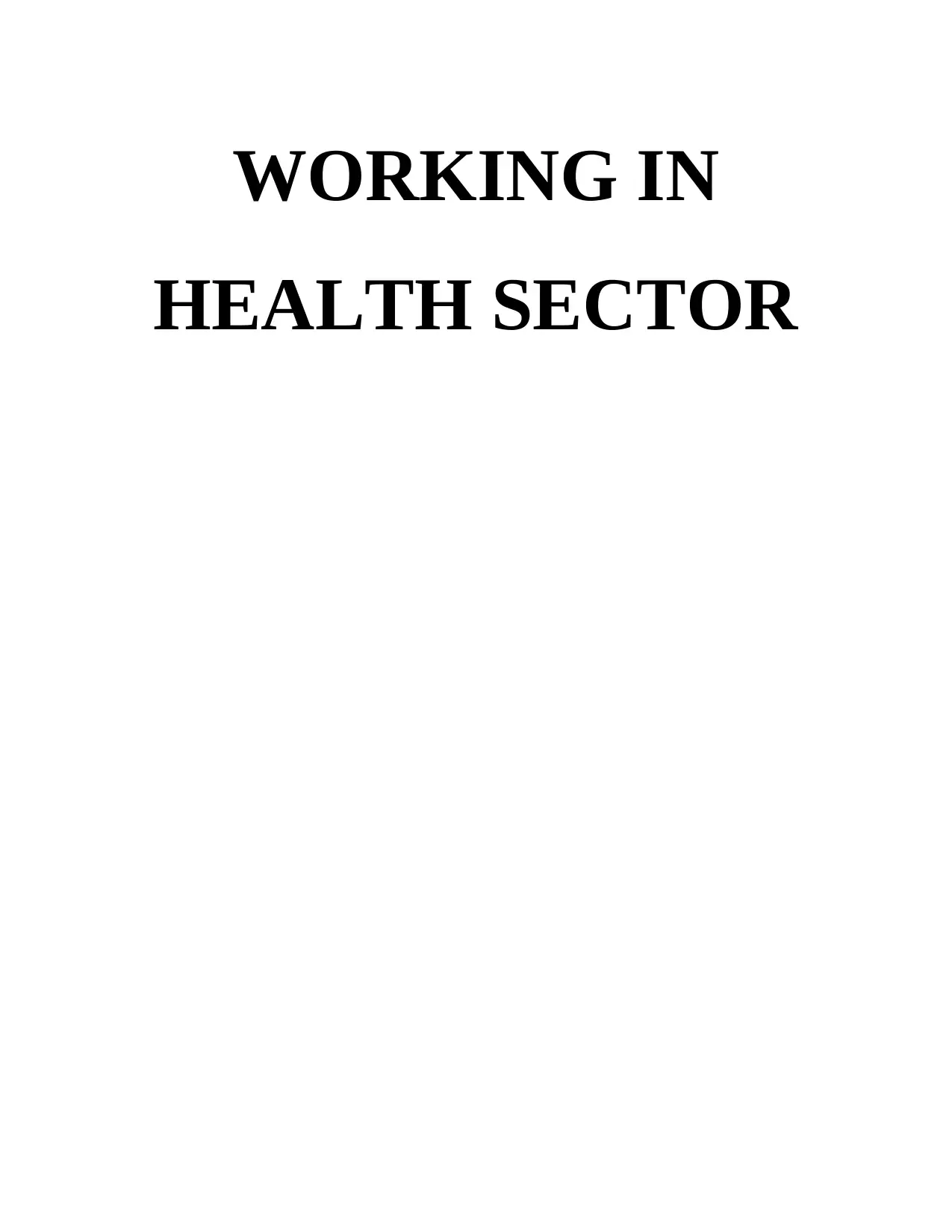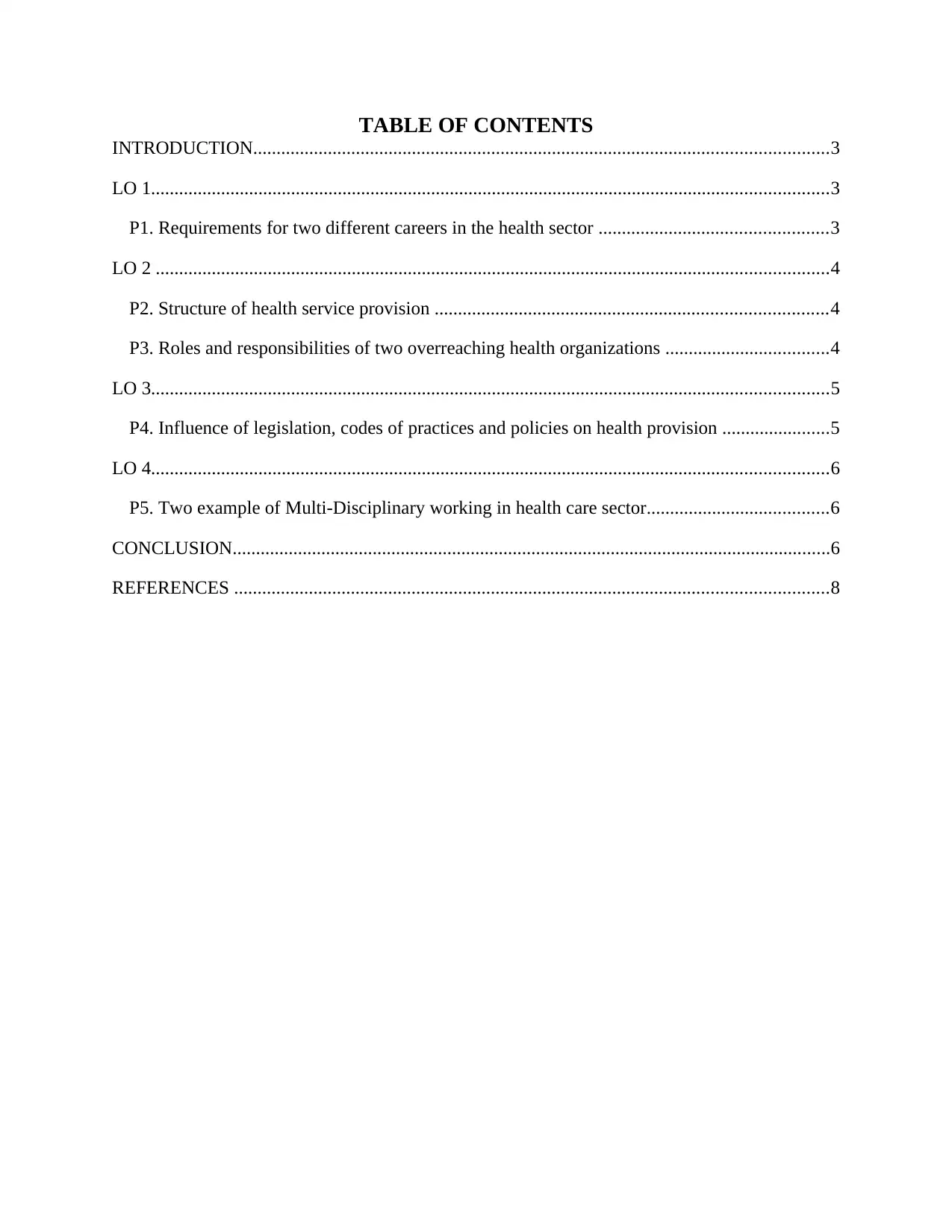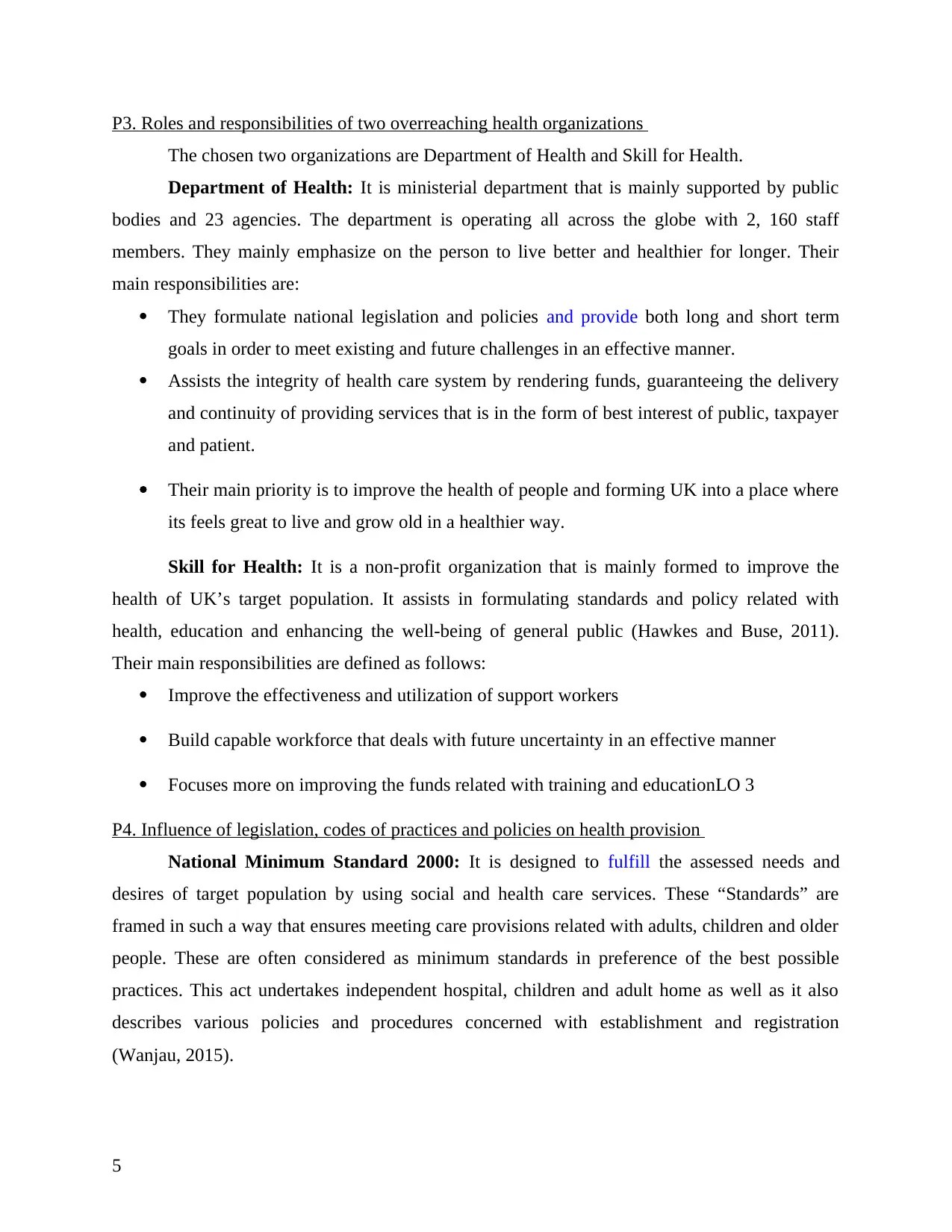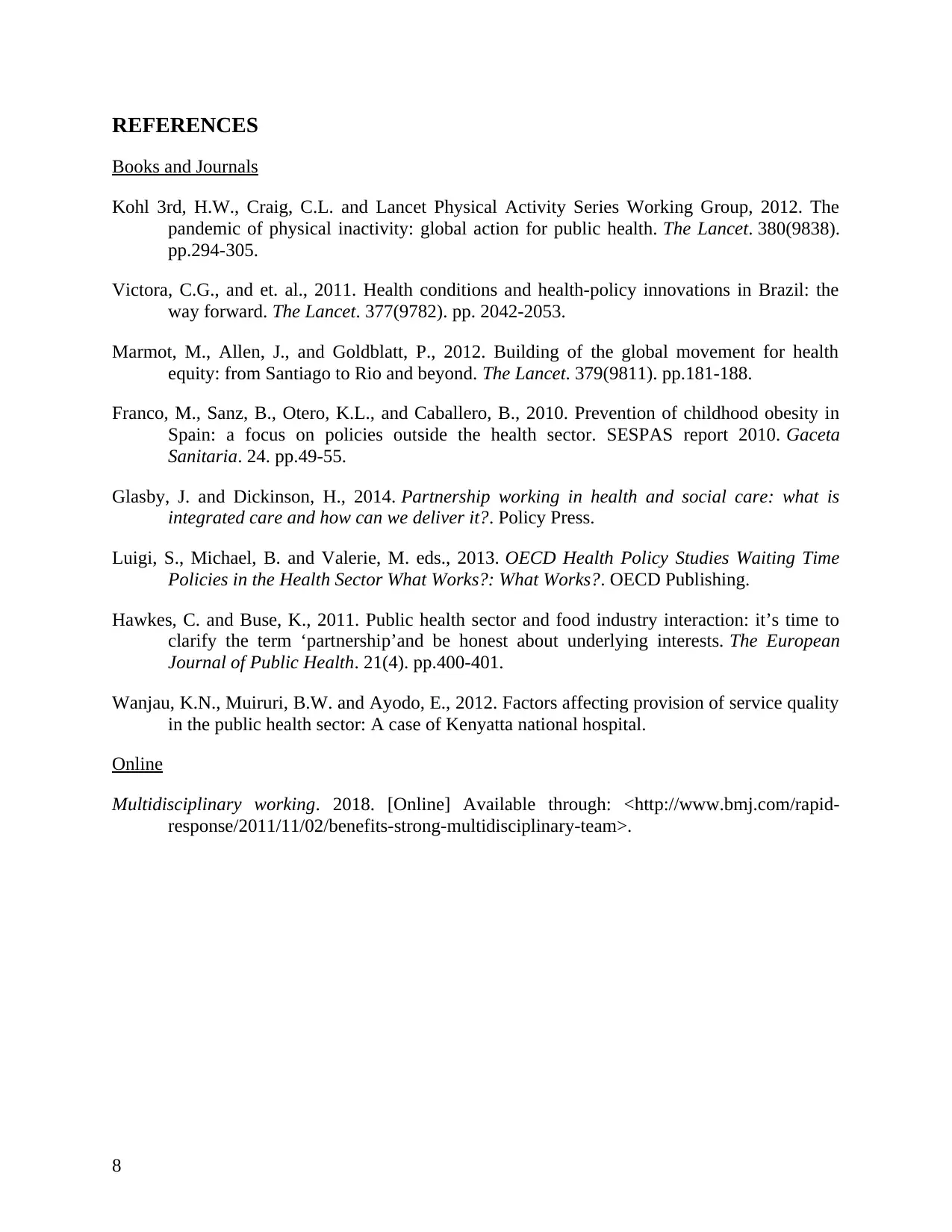Analysis of Health Sector Careers, Structure, and Policies
VerifiedAdded on 2020/06/03
|8
|2415
|46
Report
AI Summary
This report provides a comprehensive overview of the health sector, examining various career opportunities such as support workers and service managers within the National Healthcare Services (NHS). It details the structure of health service provision, categorizing it into statutory, private, voluntary, and informal sectors, and outlines the organizational structure of the NHS, including primary, secondary, and mental health care trusts. The report also explores the roles and responsibilities of key health organizations like the Department of Health and Skill for Health, along with the influence of legislation such as the National Minimum Standard 2000 and the Affordable Care Act 2010 on health provision. Furthermore, it highlights examples of multi-disciplinary working in healthcare, specifically focusing on Community Mental Health Teams and the NHS, emphasizing the importance of integrated care for improved patient outcomes. The report concludes by underscoring the significance of the health and social care sector in improving public health and the quality of life.

WORKING IN
HEALTH SECTOR
HEALTH SECTOR
Paraphrase This Document
Need a fresh take? Get an instant paraphrase of this document with our AI Paraphraser

TABLE OF CONTENTS
INTRODUCTION...........................................................................................................................3
LO 1.................................................................................................................................................3
P1. Requirements for two different careers in the health sector .................................................3
LO 2 ................................................................................................................................................4
P2. Structure of health service provision ....................................................................................4
P3. Roles and responsibilities of two overreaching health organizations ...................................4
LO 3.................................................................................................................................................5
P4. Influence of legislation, codes of practices and policies on health provision .......................5
LO 4.................................................................................................................................................6
P5. Two example of Multi-Disciplinary working in health care sector.......................................6
CONCLUSION................................................................................................................................6
REFERENCES ...............................................................................................................................8
INTRODUCTION...........................................................................................................................3
LO 1.................................................................................................................................................3
P1. Requirements for two different careers in the health sector .................................................3
LO 2 ................................................................................................................................................4
P2. Structure of health service provision ....................................................................................4
P3. Roles and responsibilities of two overreaching health organizations ...................................4
LO 3.................................................................................................................................................5
P4. Influence of legislation, codes of practices and policies on health provision .......................5
LO 4.................................................................................................................................................6
P5. Two example of Multi-Disciplinary working in health care sector.......................................6
CONCLUSION................................................................................................................................6
REFERENCES ...............................................................................................................................8

INTRODUCTION
Healthcare industry is considered as the world’s leading and fastest growing sector. It is
often considered as medical industry as it is an integration of sector that aims to provide medical
services to country’s residents (Kohl and Craig, 2015). Their main purpose is to improve the
health quality of residents, minimize medical errors and enhance the efficiency of health care
services. These types of organizations are established to fulfill the health needs and wants of
target population. This assignment talks about the services rendered by National Healthcare
Services. It will also covers the aspect of different career opportunities, structure, roles and
responsibilities and codes of practices related with health care sector.
LO 1
P1. Requirements for two different careers in the health sector
Healthcare sector is contributing tremendously towards the growth and development of
economy. Apart from improving the health of target population, the sector is well known for
providing a large number of career opportunities to people that wants to pursue their career in
health and social care. In the growing competition among various sectors, healthcare is the one
that promotes stability and growth in terms of an individual career. The scope and reach of this
field in terms of student career is unlimited. The most common career categories in this sector
are as follows:
Support Worker: Support workers provide assistance to various healthcare professionals
in context of delivering better services to patients. They mainly deal with handling patients and
effectively carrying out their daily tasks such as giving medicines on time. Through their
contribution in activities, they ensure higher comfort and well-being to patients. They also
perform various tasks in the form of maintaining record of patients, medicines prescribed,
recovery details, information related with treatment, etc. Main qualities and aspects of support
workers are empathy, literacy, communication and humanity.
Service Manager: Major role of service manager is to plan and coordinate services in the
most effective and efficient manner that is going to be provided by different health care
professionals to their patients (Marmot and Goldblatt, 2011). They are also responsible for
strategic decision making policies. Their primary responsibility is to create an environment that
3
Healthcare industry is considered as the world’s leading and fastest growing sector. It is
often considered as medical industry as it is an integration of sector that aims to provide medical
services to country’s residents (Kohl and Craig, 2015). Their main purpose is to improve the
health quality of residents, minimize medical errors and enhance the efficiency of health care
services. These types of organizations are established to fulfill the health needs and wants of
target population. This assignment talks about the services rendered by National Healthcare
Services. It will also covers the aspect of different career opportunities, structure, roles and
responsibilities and codes of practices related with health care sector.
LO 1
P1. Requirements for two different careers in the health sector
Healthcare sector is contributing tremendously towards the growth and development of
economy. Apart from improving the health of target population, the sector is well known for
providing a large number of career opportunities to people that wants to pursue their career in
health and social care. In the growing competition among various sectors, healthcare is the one
that promotes stability and growth in terms of an individual career. The scope and reach of this
field in terms of student career is unlimited. The most common career categories in this sector
are as follows:
Support Worker: Support workers provide assistance to various healthcare professionals
in context of delivering better services to patients. They mainly deal with handling patients and
effectively carrying out their daily tasks such as giving medicines on time. Through their
contribution in activities, they ensure higher comfort and well-being to patients. They also
perform various tasks in the form of maintaining record of patients, medicines prescribed,
recovery details, information related with treatment, etc. Main qualities and aspects of support
workers are empathy, literacy, communication and humanity.
Service Manager: Major role of service manager is to plan and coordinate services in the
most effective and efficient manner that is going to be provided by different health care
professionals to their patients (Marmot and Goldblatt, 2011). They are also responsible for
strategic decision making policies. Their primary responsibility is to create an environment that
3
⊘ This is a preview!⊘
Do you want full access?
Subscribe today to unlock all pages.

Trusted by 1+ million students worldwide

renders quality care services at maximum revenue or profit. To avail the benefit of such
opportunities, it is important that candidate must possess ideal education and leadership traits as
well as skills that assist them in achieving long term objectives in a structured manner.
Detailed Job Description of Service Manager
Job Profile: Service Manager
Organization Name: National Healthcare Services
Address 31 Street Centennial Park, England
Timings Any 8 Hours
Salary 35,000 to 40,000(in pounds)
Educational Qualification Graduation from recognized university
Experience 1-2 years of experience
Summary NHS is looking for committed and competent service manager
who with his skills and traits renders ideal services to patients
and users. The candidate should be able to meet the criteria
defined by company.
Roles and
Responsibilities:
Renders services that match with the defined
benchmark set by NHS.
Manage and utilize resources in the most optimum way.
Maintains record on timely basis.
Detailed Job Description of Support Worker
Job Profile: Support Worker
Organization Name: National Healthcare Services
Address 31 Street Centennial Park, England
Timings Any 9 Hours
Salary 20,000 (in pounds)
Educational Qualification Completed schooling and graduation
Experience Minimum 2 years of experience is required
Summary NHS is looking for committed and motivated supporter who
with their efficiency and effectiveness achieve organizational
objective.
Roles and
Responsibilities:
Great learning skill
Effectively manage and handle the work
LO 2
P2. Structure of health service provision
Covered in Poster
4
opportunities, it is important that candidate must possess ideal education and leadership traits as
well as skills that assist them in achieving long term objectives in a structured manner.
Detailed Job Description of Service Manager
Job Profile: Service Manager
Organization Name: National Healthcare Services
Address 31 Street Centennial Park, England
Timings Any 8 Hours
Salary 35,000 to 40,000(in pounds)
Educational Qualification Graduation from recognized university
Experience 1-2 years of experience
Summary NHS is looking for committed and competent service manager
who with his skills and traits renders ideal services to patients
and users. The candidate should be able to meet the criteria
defined by company.
Roles and
Responsibilities:
Renders services that match with the defined
benchmark set by NHS.
Manage and utilize resources in the most optimum way.
Maintains record on timely basis.
Detailed Job Description of Support Worker
Job Profile: Support Worker
Organization Name: National Healthcare Services
Address 31 Street Centennial Park, England
Timings Any 9 Hours
Salary 20,000 (in pounds)
Educational Qualification Completed schooling and graduation
Experience Minimum 2 years of experience is required
Summary NHS is looking for committed and motivated supporter who
with their efficiency and effectiveness achieve organizational
objective.
Roles and
Responsibilities:
Great learning skill
Effectively manage and handle the work
LO 2
P2. Structure of health service provision
Covered in Poster
4
Paraphrase This Document
Need a fresh take? Get an instant paraphrase of this document with our AI Paraphraser

P3. Roles and responsibilities of two overreaching health organizations
The chosen two organizations are Department of Health and Skill for Health.
Department of Health: It is ministerial department that is mainly supported by public
bodies and 23 agencies. The department is operating all across the globe with 2, 160 staff
members. They mainly emphasize on the person to live better and healthier for longer. Their
main responsibilities are:
They formulate national legislation and policies and provide both long and short term
goals in order to meet existing and future challenges in an effective manner.
Assists the integrity of health care system by rendering funds, guaranteeing the delivery
and continuity of providing services that is in the form of best interest of public, taxpayer
and patient.
Their main priority is to improve the health of people and forming UK into a place where
its feels great to live and grow old in a healthier way.
Skill for Health: It is a non-profit organization that is mainly formed to improve the
health of UK’s target population. It assists in formulating standards and policy related with
health, education and enhancing the well-being of general public (Hawkes and Buse, 2011).
Their main responsibilities are defined as follows:
Improve the effectiveness and utilization of support workers
Build capable workforce that deals with future uncertainty in an effective manner
Focuses more on improving the funds related with training and educationLO 3
P4. Influence of legislation, codes of practices and policies on health provision
National Minimum Standard 2000: It is designed to fulfill the assessed needs and
desires of target population by using social and health care services. These “Standards” are
framed in such a way that ensures meeting care provisions related with adults, children and older
people. These are often considered as minimum standards in preference of the best possible
practices. This act undertakes independent hospital, children and adult home as well as it also
describes various policies and procedures concerned with establishment and registration
(Wanjau, 2015).
5
The chosen two organizations are Department of Health and Skill for Health.
Department of Health: It is ministerial department that is mainly supported by public
bodies and 23 agencies. The department is operating all across the globe with 2, 160 staff
members. They mainly emphasize on the person to live better and healthier for longer. Their
main responsibilities are:
They formulate national legislation and policies and provide both long and short term
goals in order to meet existing and future challenges in an effective manner.
Assists the integrity of health care system by rendering funds, guaranteeing the delivery
and continuity of providing services that is in the form of best interest of public, taxpayer
and patient.
Their main priority is to improve the health of people and forming UK into a place where
its feels great to live and grow old in a healthier way.
Skill for Health: It is a non-profit organization that is mainly formed to improve the
health of UK’s target population. It assists in formulating standards and policy related with
health, education and enhancing the well-being of general public (Hawkes and Buse, 2011).
Their main responsibilities are defined as follows:
Improve the effectiveness and utilization of support workers
Build capable workforce that deals with future uncertainty in an effective manner
Focuses more on improving the funds related with training and educationLO 3
P4. Influence of legislation, codes of practices and policies on health provision
National Minimum Standard 2000: It is designed to fulfill the assessed needs and
desires of target population by using social and health care services. These “Standards” are
framed in such a way that ensures meeting care provisions related with adults, children and older
people. These are often considered as minimum standards in preference of the best possible
practices. This act undertakes independent hospital, children and adult home as well as it also
describes various policies and procedures concerned with establishment and registration
(Wanjau, 2015).
5

Affordable Care Act, 2010: This act also possesses influence on the functioning and
performance of various health and social care institutions. They lay stress on ensuring that health
care services must be availed by country’s residents in an appropriate manner and its stay within
the reach or extent of target population. Their main goal is to increase the access to health and
safety insurance, protect patients’ rights against uninformed actions by various insurance
companies and reducing the overall cost associated with this.
LO 4
P5. Two example of Multi-Disciplinary working in health care sector
The concept of Multi-Disciplinary deals with combination of two or more health care
firms in order to provide better services to target population (Multidisciplinary working, 2018).
The two examples that fall under this category are Community Mental Health Teams and
National Healthcare Services.
Community Mental Health Teams: In this method, medical practitioner from different
background and experience come together with an aim of working collectively in order to deal
with medical issues in an appropriate and efficient manner perceived by patient. For example:
Psychiatrist and Mental specialist jointly work to deal with mentally ill patients. With the help of
this integration, specialists can share their knowledge and experience as well as provide better
and effective services to patients.
National Healthcare System: It mainly focuses on rendering the services that have been
undertaken by various specialists in order to cure the patients in a systematic manner. There are
certain number of patients that possess great efforts of different specialists and thus, integrating
them for work so that they will provide better services to patient and improve their health and
quality of life. Their main purpose is to serve patient in the best possible manner even if it
involves combination of different doctors or specialists under one roof for a patient.
CONCLUSION
As per the above report. it can be concluded that health and social care is considered as
the most important sector of an economy. It deals in improving the health conditions of person
by providing them effective and efficient treatment that ultimately removes the root of illness.
6
performance of various health and social care institutions. They lay stress on ensuring that health
care services must be availed by country’s residents in an appropriate manner and its stay within
the reach or extent of target population. Their main goal is to increase the access to health and
safety insurance, protect patients’ rights against uninformed actions by various insurance
companies and reducing the overall cost associated with this.
LO 4
P5. Two example of Multi-Disciplinary working in health care sector
The concept of Multi-Disciplinary deals with combination of two or more health care
firms in order to provide better services to target population (Multidisciplinary working, 2018).
The two examples that fall under this category are Community Mental Health Teams and
National Healthcare Services.
Community Mental Health Teams: In this method, medical practitioner from different
background and experience come together with an aim of working collectively in order to deal
with medical issues in an appropriate and efficient manner perceived by patient. For example:
Psychiatrist and Mental specialist jointly work to deal with mentally ill patients. With the help of
this integration, specialists can share their knowledge and experience as well as provide better
and effective services to patients.
National Healthcare System: It mainly focuses on rendering the services that have been
undertaken by various specialists in order to cure the patients in a systematic manner. There are
certain number of patients that possess great efforts of different specialists and thus, integrating
them for work so that they will provide better services to patient and improve their health and
quality of life. Their main purpose is to serve patient in the best possible manner even if it
involves combination of different doctors or specialists under one roof for a patient.
CONCLUSION
As per the above report. it can be concluded that health and social care is considered as
the most important sector of an economy. It deals in improving the health conditions of person
by providing them effective and efficient treatment that ultimately removes the root of illness.
6
⊘ This is a preview!⊘
Do you want full access?
Subscribe today to unlock all pages.

Trusted by 1+ million students worldwide

The main effort of this sector is in the form of enhancing quality of health and social care
services in an economic and cost efficient manner.
7
services in an economic and cost efficient manner.
7
Paraphrase This Document
Need a fresh take? Get an instant paraphrase of this document with our AI Paraphraser

REFERENCES
Books and Journals
Kohl 3rd, H.W., Craig, C.L. and Lancet Physical Activity Series Working Group, 2012. The
pandemic of physical inactivity: global action for public health. The Lancet. 380(9838).
pp.294-305.
Victora, C.G., and et. al., 2011. Health conditions and health-policy innovations in Brazil: the
way forward. The Lancet. 377(9782). pp. 2042-2053.
Marmot, M., Allen, J., and Goldblatt, P., 2012. Building of the global movement for health
equity: from Santiago to Rio and beyond. The Lancet. 379(9811). pp.181-188.
Franco, M., Sanz, B., Otero, K.L., and Caballero, B., 2010. Prevention of childhood obesity in
Spain: a focus on policies outside the health sector. SESPAS report 2010. Gaceta
Sanitaria. 24. pp.49-55.
Glasby, J. and Dickinson, H., 2014. Partnership working in health and social care: what is
integrated care and how can we deliver it?. Policy Press.
Luigi, S., Michael, B. and Valerie, M. eds., 2013. OECD Health Policy Studies Waiting Time
Policies in the Health Sector What Works?: What Works?. OECD Publishing.
Hawkes, C. and Buse, K., 2011. Public health sector and food industry interaction: it’s time to
clarify the term ‘partnership’and be honest about underlying interests. The European
Journal of Public Health. 21(4). pp.400-401.
Wanjau, K.N., Muiruri, B.W. and Ayodo, E., 2012. Factors affecting provision of service quality
in the public health sector: A case of Kenyatta national hospital.
Online
Multidisciplinary working. 2018. [Online] Available through: <http://www.bmj.com/rapid-
response/2011/11/02/benefits-strong-multidisciplinary-team>.
8
Books and Journals
Kohl 3rd, H.W., Craig, C.L. and Lancet Physical Activity Series Working Group, 2012. The
pandemic of physical inactivity: global action for public health. The Lancet. 380(9838).
pp.294-305.
Victora, C.G., and et. al., 2011. Health conditions and health-policy innovations in Brazil: the
way forward. The Lancet. 377(9782). pp. 2042-2053.
Marmot, M., Allen, J., and Goldblatt, P., 2012. Building of the global movement for health
equity: from Santiago to Rio and beyond. The Lancet. 379(9811). pp.181-188.
Franco, M., Sanz, B., Otero, K.L., and Caballero, B., 2010. Prevention of childhood obesity in
Spain: a focus on policies outside the health sector. SESPAS report 2010. Gaceta
Sanitaria. 24. pp.49-55.
Glasby, J. and Dickinson, H., 2014. Partnership working in health and social care: what is
integrated care and how can we deliver it?. Policy Press.
Luigi, S., Michael, B. and Valerie, M. eds., 2013. OECD Health Policy Studies Waiting Time
Policies in the Health Sector What Works?: What Works?. OECD Publishing.
Hawkes, C. and Buse, K., 2011. Public health sector and food industry interaction: it’s time to
clarify the term ‘partnership’and be honest about underlying interests. The European
Journal of Public Health. 21(4). pp.400-401.
Wanjau, K.N., Muiruri, B.W. and Ayodo, E., 2012. Factors affecting provision of service quality
in the public health sector: A case of Kenyatta national hospital.
Online
Multidisciplinary working. 2018. [Online] Available through: <http://www.bmj.com/rapid-
response/2011/11/02/benefits-strong-multidisciplinary-team>.
8
1 out of 8
Related Documents
Your All-in-One AI-Powered Toolkit for Academic Success.
+13062052269
info@desklib.com
Available 24*7 on WhatsApp / Email
![[object Object]](/_next/static/media/star-bottom.7253800d.svg)
Unlock your academic potential
Copyright © 2020–2025 A2Z Services. All Rights Reserved. Developed and managed by ZUCOL.





